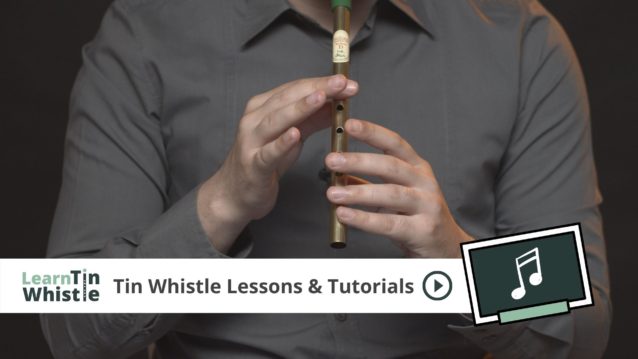In this lesson, talk about how (and where) to properly use your tongue while playing a tin whistle. The truth is, you can play a tune without using the tongue at all and use ornaments and other embellishments instead. But, sadly to say, those who don’t get the tin whistle tonguing right are most probably playing unarticulated music. Also, improper tonguing may lead to problems with controlling the airflow too.
Why use tonguing on a tin whistle?
Technically, you use your tongue to split a single long note into multiple separate notes of the same pitch. It’s the most basic way of playing repeated notes. Or, use it when jumping from lower to upper octave to avoid squeaks. But, most importantly, tonguing is what gives the accent to a melody and shapes your playing style in the first place. In classical music and for other non-wind instruments, the common term for accenting notes is called staccato. That’s what basically is the tonguing for the tin whistle. Ultimately, how often you use the tongue will depend on the feeling you want to express while playing the whistle.
How to use the tongue correctly?
Basically, you just say “T” or “Too” or “Tuh” or “Tah” or “Toh” while blowing into the whistle. However, this may not be straightforward, depending on the language you natively speak. It just may not come naturally. Try with a couple of variations until you are satisfied with the sound. Just as with blowing pressure, this “T” doesn’t have to be too sharp but also not too soft.
To prevent any confusion, make sure to avoid hitting the mouthpiece. Your tongue tip should touch your palate, very similar to how you speak. What it actually does is stopping the airflow for a moment and letting it through again. So, we want this transition to happen as fast as possible, regardless of the tempo in which we play. Do not stop blowing while using the tongue as we don’t want to “play a pause”. It is something completely different, which we’ll talk about in more detail in the upcoming lessons.
Besides playing repeated notes, tonguing is what gives the accent to a melody and defines your playing style in the first place.
LearnTinWhistle.com
Basic exercise on tin whistle tonguing
Similar to the blowing, just try to play the low scale (D, E, F#, G, A, B, C#, D) and backward, tonguing each note. You can also tongue the same note a couple of times before you move to the next one. Once you get a good feeling about the sound, continue with the upper octave, and then try a random variation of the notes. Feel free to be creative.
Examples of tonguing in songs
Below is a demonstration of the Star of the County Down, where we use tonguing to play repeated notes. And also, the second example is the song Peggy Lettermore where we tongue to accent the notes and shape the melody.
And here’s the sheet music and a visual representation of the examples. So you can easily demystify what’s played in the video. Tongued notes are marked with the letter “T”.

Feel free to download PDFs for better quality and to keep it locally and practice whenever you want.

You may notice that in Peggy Lettermore, tonguing is used mostly on the note A. This is not a strict rule or anything similar, it is just an example. Try to switch the tonguing positions later. For a quick example, skip tonguing on A and use it mostly on F# notes. You should hear how the different tonguing positions can shape the overall flow of the tune.
Tonguing patterns in Irish traditional music (i.e. jigs & reels)
If your goal is to play Irish traditional music, this explanation might be slightly advanced. However, it’s not bad to give it a mention. In jigs, which are 6/8 signature tunes connected in 1-2-3 rhythmical phrases, you can usually tongue notes 2 and 3. This will make the tune accented as pronouncing “ha-ta-ta”, “ha-ta-ta”. It’s not a requirement but a good place to start thinking of.
When playing 4/4 signature tunes such as reels, there’s no rule of thumb as it usually depends on the melody itself. Sometimes, you want to use your tongue on odd eighth notes only, avoiding to tongue the even notes. Or the opposite, use your tongue on even notes only and skip the odd ones. To make this more clear, since a reel is a 1-2-3-4 rhythmical phrase, we may want to use the tongue on notes 1 & 3. Or the opposite: 2 & 4.
There is, however, another widely used pattern, which is to tongue the notes 2 & 3 and skip tonguing on 1 & 4. Frankly, there are a lot of combinations that may fit the melody and you’ll get a sense of it mostly by listening to Irish traditional music.
Another great example of tin whistle tonguing
As a beginner, this video below is not here to get you demotivated. Quite the contrary, it showcases how tin whistle tonguing can go a long way. The tune is played by Brian Finnegan, arguably one of the best whistle players in history. Concentrate on this recording to hear how his tonguing (besides other ornaments) provides the attitude and a punchy feeling. The tune set sounds so convincing.





what type of whistle is Brian Finnegin playing ?
Hello Frank,
Brian Finnegan almost exclusively plays Goldie whistles. They are made of aluminum.